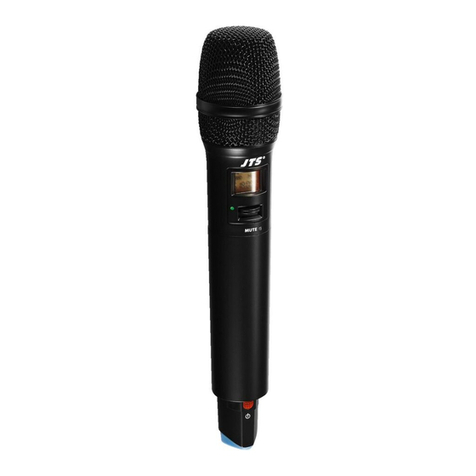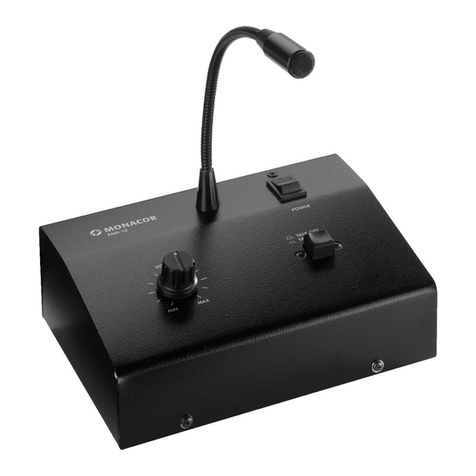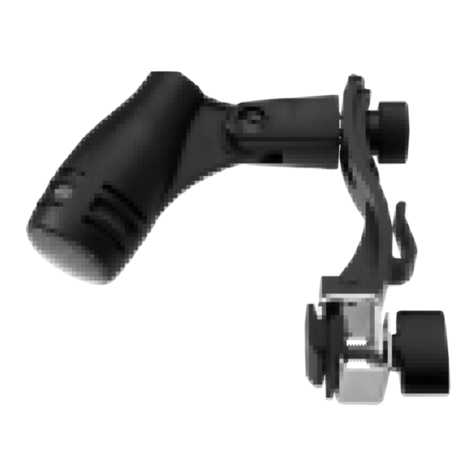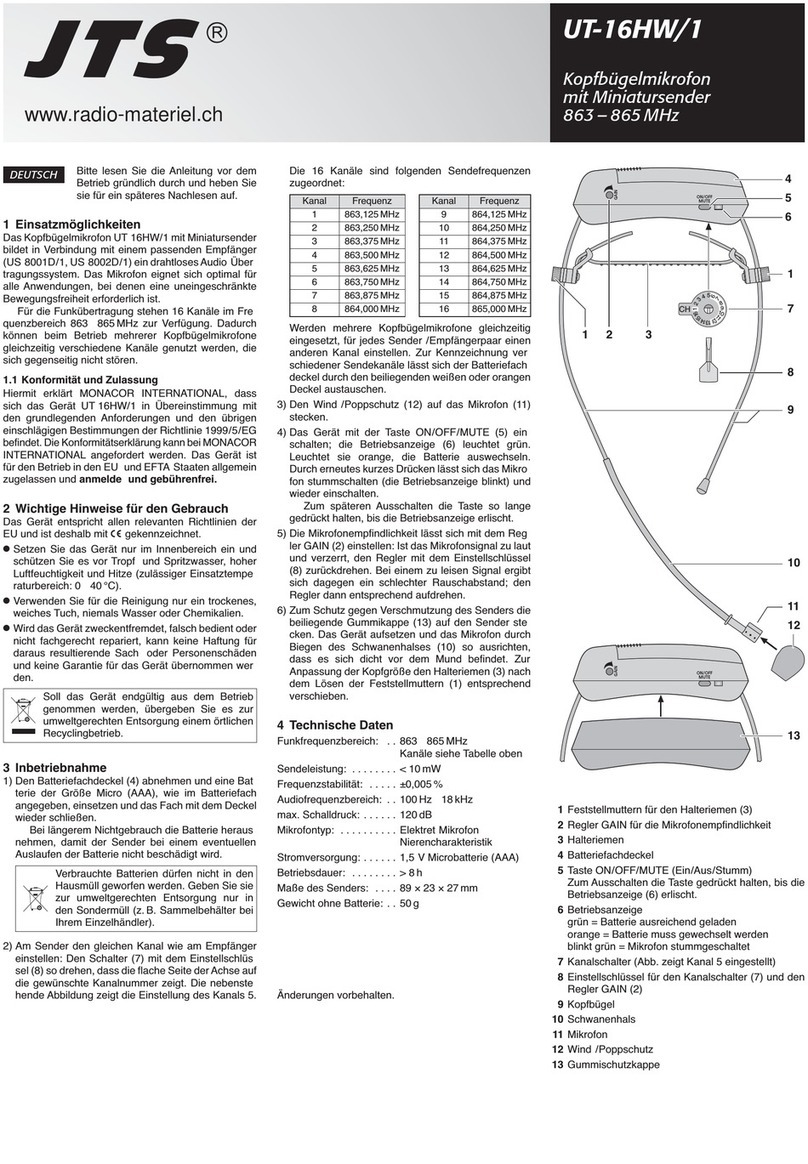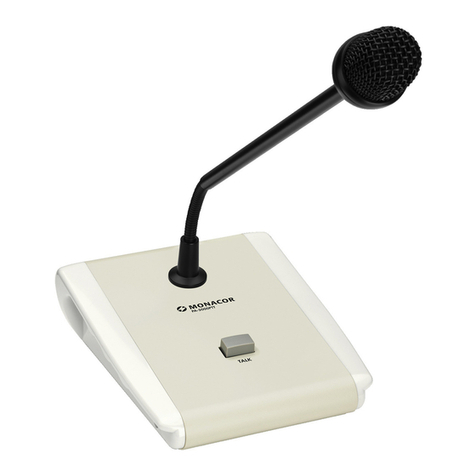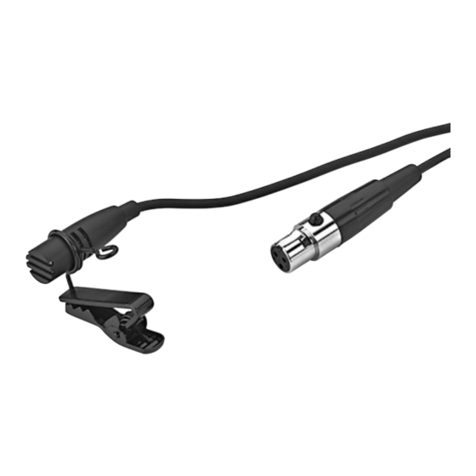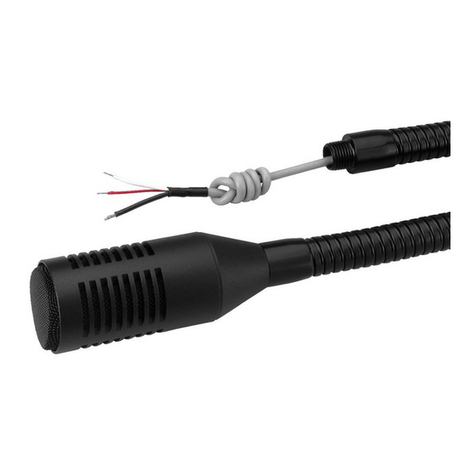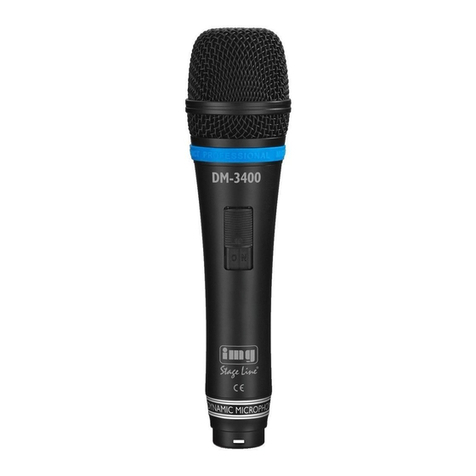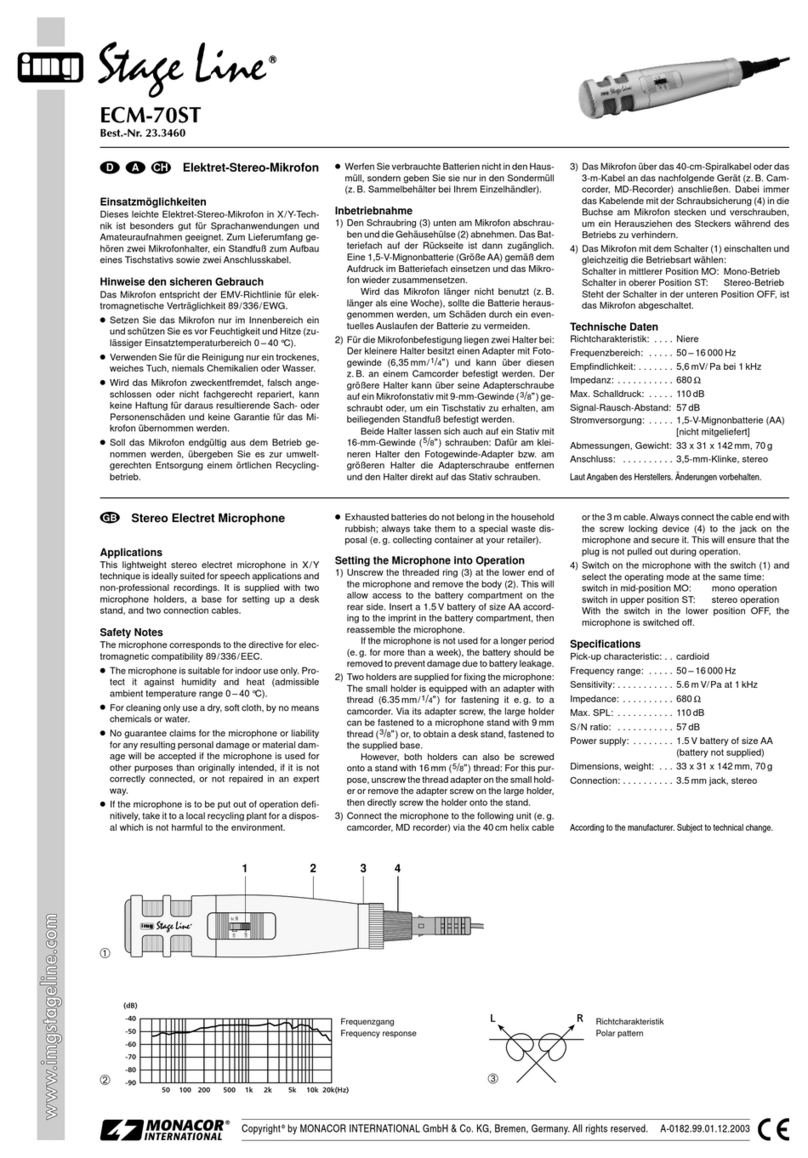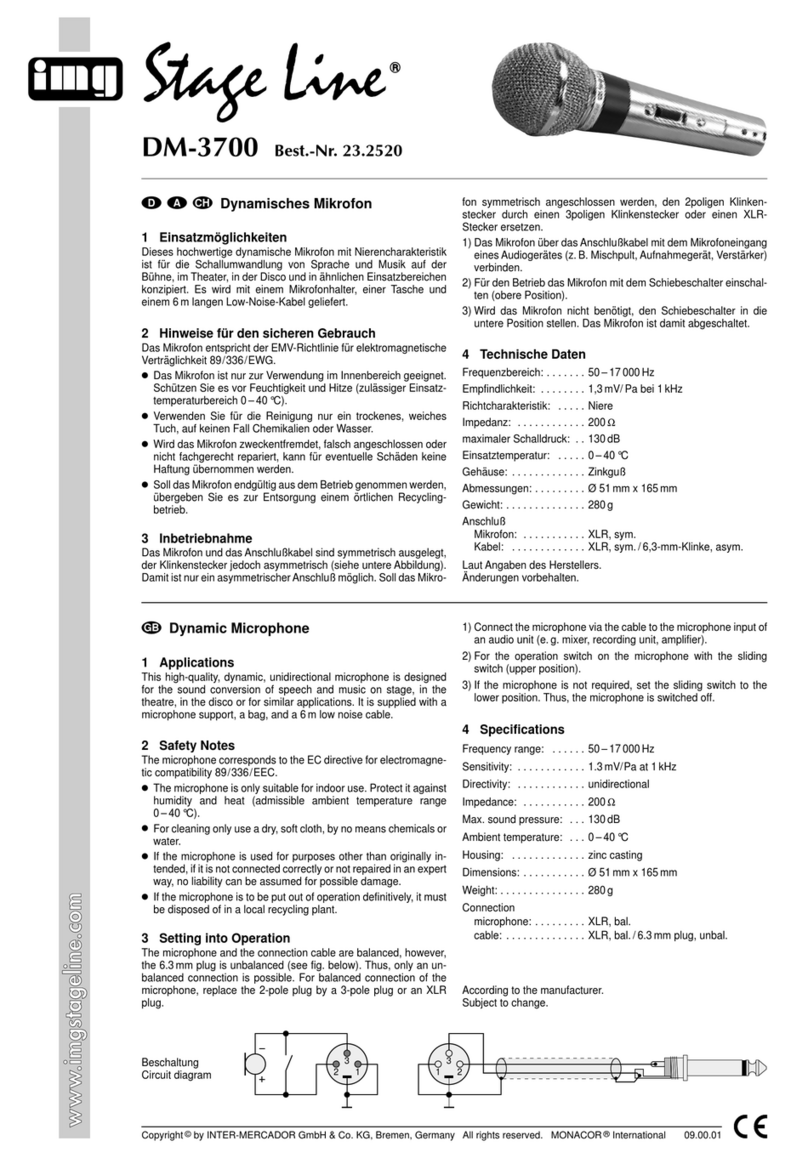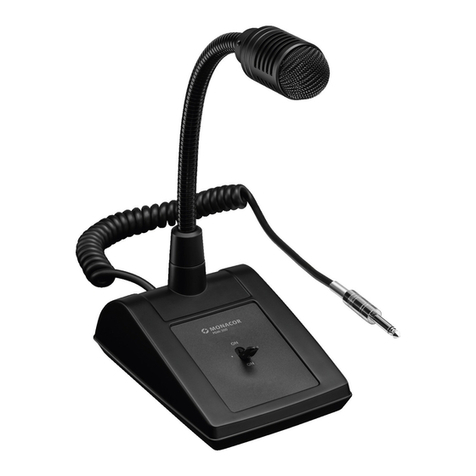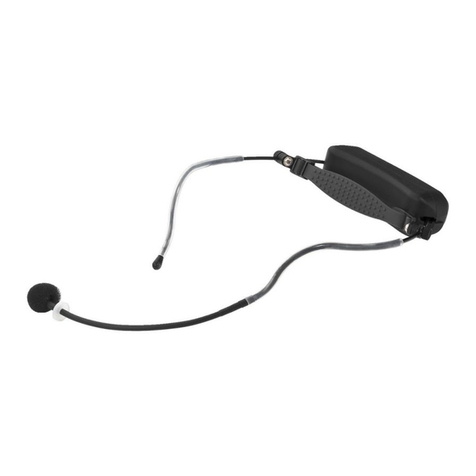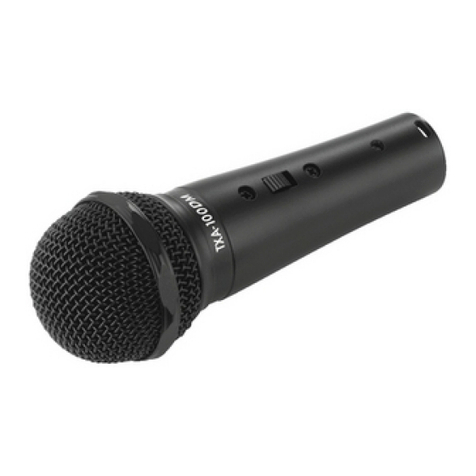Microphone électret
stéréo
Possibilités d’utilisation
Lemicrophone stéréoECM-220ST esttrès bienadap-
té pour des utilisations professionnelles en studio.
Chacune des deux capsules back électret cardioïdes
nécessite, pour son fonctionnement, une alimentation
fantôme 48V. Le micro est symétrisé par transfo et
dispose d’un filtre commutable Low Cut passe-haut.
Il est livré avec un coffret plastique, une pince
micro et un cordon de 5m.
Conseils d’utilisation et de sécurité
Lemicrophone répondàla normeeuropéenne89/336/
CEE, relative à la compatibilité électromagnétique.
●Le microphone n’est conçu que pour une utilisation
en intérieur. Protégez le microphone de l’humidité
et de la chaleur (plage de température de fonc-
tionnement autorisée 0–40°C).
●Pour le nettoyer, utilisez uniquement un chiffon sec
et doux, en aucun cas de produits chimiques ou
d’eau.
●Nous déclinons toute responsabilité en cas de
dommages matériels ou corporels résultants si le
microphone est utilisé dans un but autre que celui
pour lequel il a été conçu, s’il n’est pas correcte-
ment branché ou s’il n’est pas réparé par une per-
sonne habilitée ; en outre, la garantie deviendrait
caduque.
●Lorsque le microphone est définitivement retiré du
circuit de distribution, vous devez le déposer dans
une usine de recyclage adaptée pour contribuer à
son élimination non polluante.
Mise en service
1) Poussez le micro dans la pince livrée et vissez-la
sur un pied micro :
Pour un pied avec un filetage 16mm (5/8"), reti-
rez la vis d’adaptation sur la pince et vissez direc-
tement la pince. Pour un pied avec un filetage
9mm (3/8"), fixez la pince sur la vis d’adaptation.
2) Reliez la prise XLR 5 pôles femelle du cordon livré
au micro.
3) Reliez les deux prises XLR 3 pôles du cordon (re-
père gris sur la prise = canal gauche, repère rouge
sur la prise = canal droit) avec deux entrées micro
XLR symétriques sur l’appareil audio, p.ex. table
de mixage. Les entrées doivent respectivement
être dotées d’une alimentation fantôme 48V .
Si l’appareil audio ne propose d’alimentation
fantôme, reliez le micro via un appareil externe
d’alimentation fantôme (p.ex. EMA-200 de “img
Stage Line”) à l’appareil audio.
4) Pour diminuer les fréquences basses, le micro dis-
pose d’un filtre Low Cut (passe-haut). Pour allumer
le filtre, poussez l’interrupteur encastré avec un
objet de petites dimensions (p.ex. petit tournevis)
dans la position .
Caractéristiques techniques
Type/directivité : . . . . . . . électret/cardioïde
Bande passante : . . . . . . 50–16000Hz
Sensibilité : . . . . . . . . . . . 5mV/Pa à 1kHz
Impédance : . . . . . . . . . . 200Ω
Pression sonore max. : . . 120dB
Rapport signal/bruit : . . . 55dB
Alimentation : . . . . . . . . . alimentation fantôme 48V
par capsule micro
Dimensions, poids : . . . . 75 x 195 x 50mm, 200g
Branchement
Micro : . . . . . . . . . . . . XLR 5 pôles, symétrique
Cordon 5 m : . . . . . . . 1 x XLR 5 pôles femelle /
2 x XLR 3 pôles mâle
D’après les données du constructeur.
Tout droit de modification réservé.
Microfono stereo a elettrete
Possibilità d’impiego
Il microfono stereo ECM-220ST è adatto per l’impiego
professionale negli studi di registrazione. Le due cap-
sule a back-elettrete a cardioide richiedono ognuno
un’alimentazione phantom di 48V. Il microfono è a
trasmissione simmetrica e dispone di un filtro low-cut
commutabile. Sono in dotazione una valigetta di pla-
stica, un supporto e un cavo di collegamento di 5m.
Avvertenze di sicurezza
Il microfono è conforme alla direttiva CE 89/336/CEE
sulla compatibilità elettromagnetica.
●Usare il microfono solo all’interno di locali e proteg-
gerlo dall’umidità e dal calore (temperatura d’im-
piego ammessa fra 0 e 40°C).
●Per la pulizia usare solo un panno morbido, asciut-
to; non impiegare in nessun caso prodotti chimici o
acqua.
●Nel caso d’uso improprio, di collegamenti sbagliati
o di riparazione scorretta del microfono, non si
assumenessuna responsabilitàpereventuali danni
consequenzialia persone oa cosee non siassume
nessuna garanzia per il microfono.
●Se si desidera eliminare il microfono definitiva-
mente, consegnarlo per lo smaltimento ad un’istitu-
zione locale per il riciclaggio.
Messa in funzione
1) Inserire il microfono sul supporto in dotazione e
avvitare questo su uno stativo per microfoni:
nel caso di uno stativo con filettatura di 16mm
(5/8"), togliere l’adattatore posto sul supporto e
avvitare il supporto direttamente sullo stativo. Con
uno stativo con filettatura di 9mm (3/8") occorre
usare l’adattatore.
2) Collegare il connettore XLR femmina a 5 poli del
cavo in dotazione con il microfono.
3) Collegarei due connettoriXLR maschio a3 poli del
cavo (contrassegno grigio sul connettore = canale
sinistro, contrassegno rosso = canale destro) con
due ingressi XLR simmetrici per microfoni dell’ap-
parecchio audio, p.es. del mixer. Gli ingressi
devono possedere ognuno un’alimentazione
phantom 48V . Se l’apparecchio audio non dis-
pone di alimentazione phantom, occorre collegare
il microfono per mezzo di un alimentatore phantom
esterno (p.es. EMA-200 di “img Stage Line)” sul
apparecchio audio.
4) Per abbassare le frequenze basse, il microfono
dispone di un filtro low-cut (passaalto). Per attivare
il filtro portare l’interruttore incassato in posizione
per mezzo di un oggetto stretto (p.es. di un pic-
colo cacciavite).
Dati tecnici
Tipo/proprietà direzionale: elettrete/cardioide
Banda di frequenze: . . . . 50–16000Hz
Sensibilità: . . . . . . . . . . . 5mV/Pa a 1kHz
Impedenza: . . . . . . . . . . . 200Ω
Pressione sonora max.: . 120dB
Rapporto S/R: . . . . . . . . 55dB
Alimentazione: . . . . . . . . alimentazione phantom
48V per ogni capsula
Dimensioni, peso: . . . . . . 75 x 195 x 50mm, 200g
Collegamento:
microfono: . . . . . . . . . XLR a 5 poli, simm.
cavo 5m: . . . . . . . . . . 1 x XLR femmina a 5 poli
2 x XLR maschio a 3 poli
Dati forniti dal costruttore.
Con riserva di modifiche tecniche.
ECM-220ST
Best.-Nr. 23.3470
wwwwww..iimmggssttaaggeelliinnee..ccoomm
Copyright©by MONACOR INTERNATIONAL GmbH & Co. KG, Bremen, Germany. All rights reserved. A-0192.99.01.01.2004
®
Stereofoniczny Mikrofon
Elektretowy
Zastosowanie
Stereofoniczny mikrofon elektretowy ECM-22 ST
przeznaczony jest do profesjonalnych zastosowań
studyjnych. Wyposażony jest w dwie elektretowe
wkładki mikrofonowe o charakterystykach kierunko-
wych. Obie wymagają zasilania fantomowego 48 V.
Mikrofon jest symetryzowany za pomocą transfor-
matora. Wyposażony jest we włączany filtr górno-
przepustowy. W zestawie oprócz mikrofonu znajduje
się plastikowe opakowanie, uchwyt mikrofonowy
oraz 5 m kabel mikrofonowy.
Informacje Dotyczące Bezpieczeństwa
Mikrofon spełnia wytyczne norm zgodności elektro-
magnetycznej 89/336/EEC.
●Mikrofon nadaje się do pracy wewnątrz pomiesz-
czeń. Należy chronić go przed gorącem oraz wil-
gocią (dopuszczalny zakres temperatury pracy
wynosi – 4 °C).
●Do czyszczenia urządzenia używać tylko suchej,
delikatnej ścierki – nie używać wody, ani chemicz-
nych środków czystościowych.
●Jeśli urządzenie jest wykorzystywane niezgodnie
z jego przeznaczeniem, jest niewłaściwe po-
dłączane, lub gdy naprawy dokonywane są przez
osoby nieupoważnione pełną odpowiedzialność
za szkody ponosi użytkownik.
●Jeżeli urządzenie nie będzie już nigdy używane
należy oddać je do miejsca utylizacji odpadów,
gdzie zostanie zniszczone bez szkody dla środo-
wiska.
Obsł ga
1) Wsunąć mikrofon w uchwyt. Uchwyt dokręcić do
statywu mikrofonowego:
W przypadku, gdy średnica gwintu statywu
mikrofonowego wynosi 16 mm (5/8"), należy
usunąć śrubę adaptacyjną uchwytu i dokręcić go
bezpośrednio do statywu. Jeżeli średnica gwintu
statywu wynosi 9 mm (3/8"), należy zamocować
do niego uchwyt stosując śrubę adaptacyjną.
2) Do gniazda wyjściowego mikrofonu podłączyć
dołączony kabel mikrofonowy.
3) Podłączyć drugi koniec kabla zakończony dwoma
wtykami XLR (wtyk oznaczony szarym kolorem =
kanał lewy, wtyk oznaczony czerwonym kolorem
= kanał prawy) do dwóch wejść mikrofonowych
urządzenia audio np.: miksera. Oba wejścia
urządzenia audio muszą być wyposażone w zasi-
lanie fantomowe 48 V prądu stałego. Jeżeli
urządzenie audio nie posiada wejść mikrofono-
wych wyposażonych w zasilanie fantomowe,
należy zastosować zewnętrzne zasilacze fanto-
mowe (np.: EMA-2 z oferty “img Stage Line”).
4) Mikrofon wyposażony jest w filtr górnoprzepu-
stowy. Aby go uaktywnić należy przesunąć
przełącznik za pomocą wąskiego przełącznika
(np.: niewielkiego śrubokręta) do pozycji .
Dane Techniczne
Typ/charakterystyka kierunkowa: elektretowy/kołowa
Zakres częstotliwości: . . . . . . . 50 – 16 000 z
Czułość: . . . . . . . . . . . . . . . . 5 mV/Pa przy 1k z,
Impedancja: . . . . . . . . . . . . . . 200 Ω
Maks. SPL: . . . . . . . . . . . . . . . 120 dB
Współczynnik S/N: . . . . . . . . . 55 dB
Zasilanie: . . . . . . . . . . . . . . . . fantomowe 48 V DC osobno dla
każdej wkładki
Wymiary, waga: . . . . . . . . . . . . 75 x 195 x 50 mm, 200g
Połączenia
Mikrofon: . . . . . . . . . . . . . XLR (5 pin) synchroniczne
5 m kabel: . . . . . . . . . . . . . 1 x wtyk XLR (5 pin)
2 x wtyk XLR (3 pin)
Zgodnie z danymi producenta. Może ulec zmianie.
F B CH
I
PL
